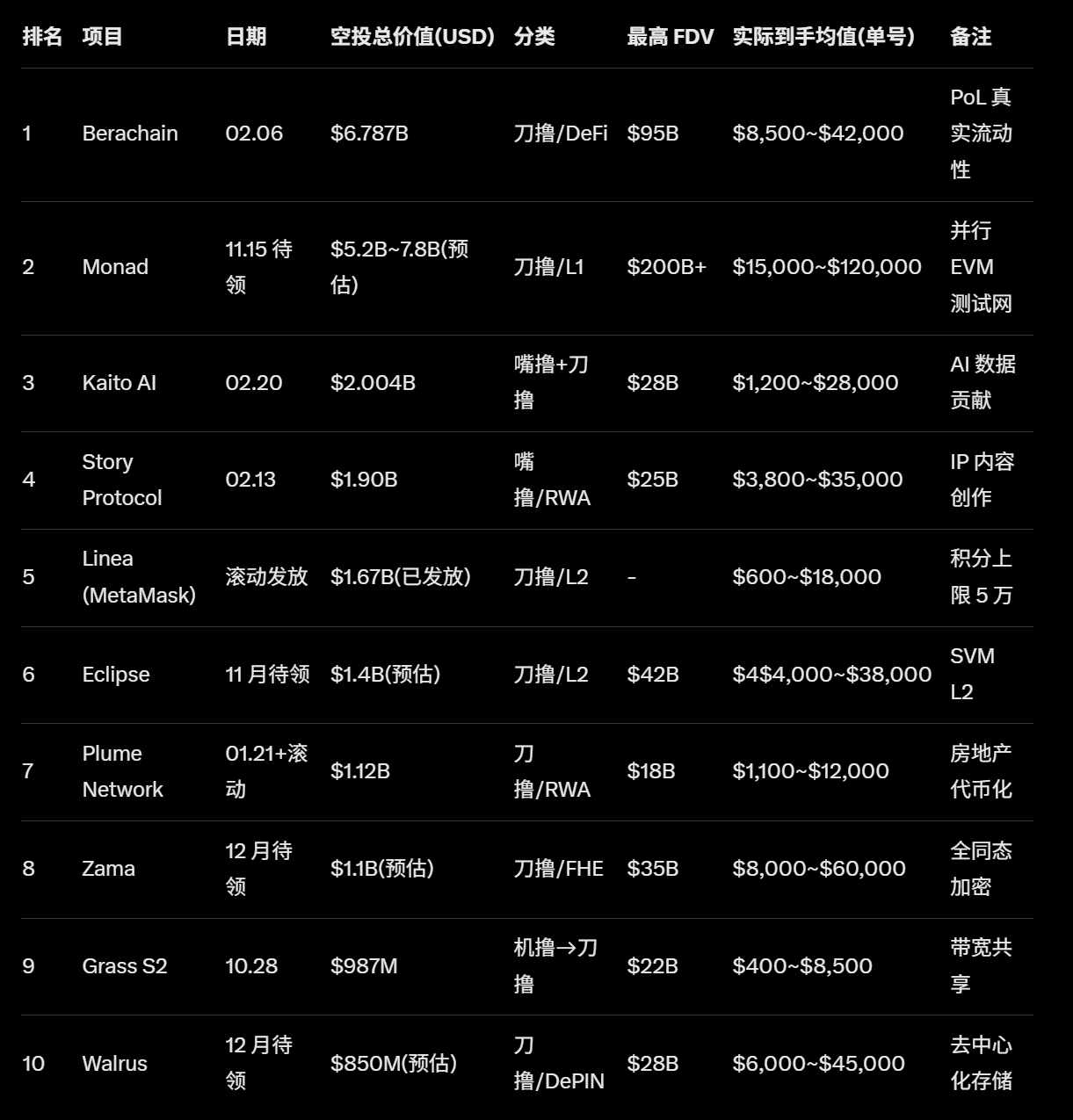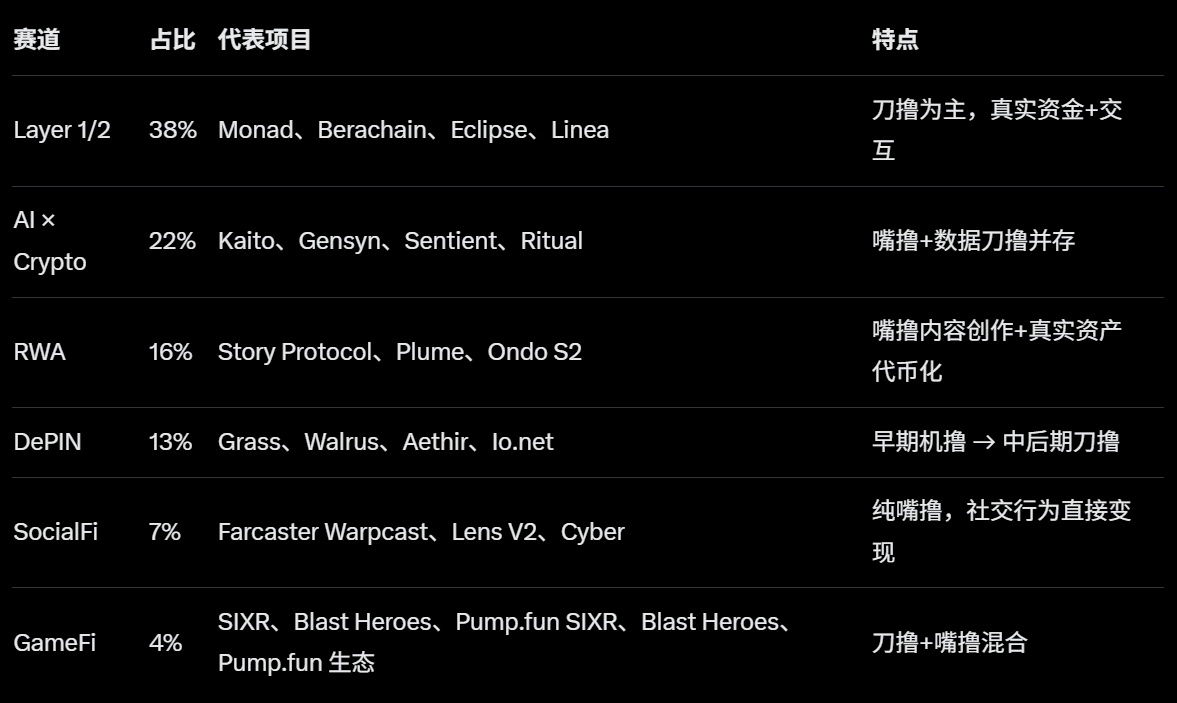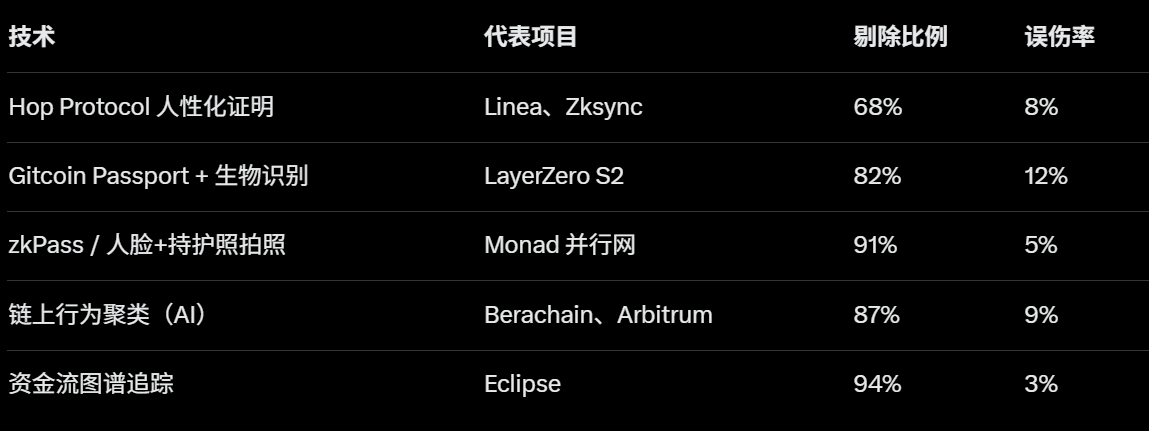
Hello everyone, I am Nancy from Coinmanlabs. Today is November 20, 2025. With the closure of the Monad airdrop claim window, the largest airdrop of the year has come to an end. This year, we witnessed the shift of airdrops from task-based point farming to on-chain labor compensation.
As more and more people learn about airdrops in 2025, various so-called airdrop studios have emerged. However, airdrops have evolved from simple free benefits into complex economic games. For example, you provide liquidity to Berachain to earn BERA, you contribute bandwidth to Grass to earn GRASS, and you can even just post and shout about trades on X every day to be marked by project parties as a participant to receive airdrops.
In 2025, airdrops can be divided into four factions:
Manual Brushing (traditional tasks + on-chain interactions): This is the oldest and most basic gameplay, suitable for small capital players, but the returns have severely shrunk.
Automated Brushing (real capital + high risk and high return): Using real money to play, injecting liquidity into projects, running nodes, and high-frequency trading is considered the mainstream by 2025.
Automated Brushing (scripts, multi-open, clusters): Once a highly profitable gameplay, but by 2025 it has been heavily targeted, with some studios being completely wiped out.
Content Creation (social content + KOL influence): The strongest dark horse track in 2025, using your voice (posting, writing articles, making videos) to earn airdrops, with zero capital threshold.
This article will analyze these four factions; with only a month left in 2025, I hope that after reading it, you won't miss out in 2026.
1. 2025 Airdrop Total Value Ranking

Data Explanation:
The total value of airdrops is calculated based on initial FDV or peak prices, actual circulating values may vary due to market fluctuations.
'Actual received average' is based on community feedback and Dune data statistics, with significant differences in account weights.
Projects marked as 'estimated' have not yet officially TGE, and data is extrapolated based on pre-market prices.
1.2 2025 Airdrop Field Distribution Ratio

1.3 2025 Airdrop Ecosystem Trends
Trend 1: Automated Brushing becomes the absolute mainstream, with gradually increasing thresholds (if you don’t bring funds to the table, don’t expect to share the meat).
In 2023, you only need to spend $100-1000 in Gas fees to interact with each project to receive airdrops. However, by 2025, the real barriers for top projects have increased significantly; project parties have completely seen through 'brushing' behavior, preferring to give money to real users rather than to witches. The logic in 2025 is: if you don't invest real money into the project, you won't have any points/snapshot qualifications at all.
Trend 2: Content Creation is rising, marking the year of social content monetization.
The biggest dark horse in 2025 is the full-blown emergence of the 'Content Creation' field. Projects need community voice → turning posts, shout-outs, long articles, and video shooting into quantifiable on-chain contributions → rewarding tokens.
Trend 3: Automated brushing is dying, AI witch hunting hit rate is over 90%+.
2025 is the year of witch hunting. Project parties generally adopt AI behavior profiling, zkPass biometric identification, and capital flow chart tracking; traditional clusters of 500-2000 small accounts are almost completely wiped out. Those that survive are basically real capital automated or content creators.
1.4 Content Creation Track Analysis
What is Content Creation? Content Creation = Using your voice (social content creation) to earn airdrops.
Core logic: Projects need community voice → turning posts, shout-outs, long articles, and video shooting into quantifiable on-chain contributions → rewarding tokens. The biggest difference from traditional 'task brushing' is that Content Creation requires real content quality and interaction volume, not copy-pasting.
Content Creation Revenue Model Formula: Total Revenue ≈ (Content Quality × Interaction Volume × Project Budget Weight) × Token Price.
Currently, this track is becoming increasingly competitive, and the gameplay is gradually advancing:
Advanced 1: Multi-platform Matrix: X (Twitter) + Farcaster multi-open. Post the same content on multiple platforms, each platform has corresponding projects scoring with it. By 2025, top players in this space are mostly 'multi-openers'.
Advanced 2: Content Pyramid: 70% short tweets (hundreds per week to maintain activity), 20% threads (2-3 in-depth analyses per week), 10% long articles/videos (one heavyweight per month). I personally believe this ratio is the standard configuration for top players in 2025. Short tweets maintain exposure, threads showcase depth, and long articles create a professional image.
Advanced 3: Seize the first release: Write the first in-depth strategy within 24 hours of a project's test net launch, with reward weight ×3-5. After Monad's test net went live, the first batch of KOLs who published strategies received additional 'early contributor' scores.
Advanced 4: Language Arbitrage: Chinese content in the SoSoValue Chinese circle is highly rewarded. The English circle is very competitive, but competition in the Chinese circle is relatively small. In 2025, the average revenue per report in the SoSoValue Chinese research is 3-5 times that of English reports.
Advanced 5: Mutual Aid Alliance: Small groups mutually like and comment, increasing interaction by 5-10 times. But be careful: they cannot be zombie accounts; they must be real active accounts helping each other, otherwise, they will be judged as 'mutual brushing witches'.
The costs and risks of Content Creation:
Mainly involves time costs: Top players: 4-6 hours per day, full-time operation; Intermediate players: 1-2 hours per day, part-time; Entry-level players: 0.5-1 hour per day, fragmented time.
Risk Points:
Account ban risks: In the second half of 2025, the X platform conducted multiple rounds of cleaning against 'spam marketing accounts', resulting in a large number of accounts specifically for 'Content Creation' being banned, with points reset to zero. Survival rule: must use real accounts to post real content, cannot post 100 empty project posts in a day.
Severe competition: The top players in this field are all KOL level, and it is very difficult for ordinary people to break into the Top 10 of the weekly rankings. In 2025, the average number of followers for Kaito's Top 10 is over 20,000, making it almost impossible for newcomers to break into the rankings. However, even in the Top 100-500, one can still earn thousands to tens of thousands of dollars.
1.5 Automated Brushing Field
'Manual brushing' becoming popular in 2025 is not accidental but rather a necessary product of the evolution of the entire airdrop ecosystem to a higher stage. Simply put: project parties have closed the door on 'free lunches', forcing users to bring 'real money to the table'.
Four fundamental reasons emerged:
Project parties have completely seen through 'brusher' behavior: In 2023-2024, a task could earn several thousand dollars just by brushing with 500 small accounts, and project parties lost 40-70% of their airdrop budget to witches. By 2025, top projects like Berachain, Monad, Zama, Eclipse, etc., have directly announced 'only rewarding genuine on-chain economic behavior'—if you don't invest real money, you won't have any points/snapshot qualifications.
The amount of airdrops is too large; project parties must bind long-term users with 'real money': In 2025, the total airdrop amount for a single project can reach hundreds of millions of dollars; casually giving it to brushers is equivalent to aiding the enemy. Only by having users invest real money can the interests be deeply tied to the project, preventing immediate sell-off after TGE.
Witch defense technology has evolved to 'capital thresholds' that are the simplest and most effective: Project parties have found that by setting a 'minimum $5,000-10,000 on-chain activity' hard threshold, they can eliminate over 90% of witch clusters in one go.
Capital demands that projects must achieve real TVL and economic cycles: By 2025, top projects’ financing easily exceeds $100 million; VCs are no longer satisfied with 'number of users' or 'number of transactions', they only look at TVL (total value locked) and protocol income. To boost TVL, users must deposit real money → manual brushing has become the most direct KPI achievement method.
In 2025, airdrops have become so expensive that project parties can no longer afford to issue 'free' ones; they can only issue 'paid' ones—if you don’t first bring real money to the table, you won’t be able to share the meat. Thus, 'earning rewards' has officially evolved into 'bringing funds to the table to eat', marking the official start of the automated brushing era.
1.5 Evolution of Witch Hunting and Anti-Hunting Technologies
2025 is the peak year for the arms race between witch attacks and defenses. The game between project parties and witches has entered a heated phase, with the final outcome: traditional automated brushing clusters are almost entirely wiped out, while manual brushing and content creation have successfully broken through.

Traditional clusters of 500-2000 small accounts are almost completely wiped out; those that survive are basically real capital automated or content creators.
Witch defense technologies:
Capital Flow Chart Tracking (hit rate 94%): By analyzing on-chain capital flows, tracking all addresses distributed from the same source address. Eclipse directly eliminated all clusters that received funds from the same address within 30 days during selection.
zkPass Biometric Identification (hit rate 91%): Monad requires users to take photos with their passport + facial recognition to ensure one person per account. By 2025, accounts that have not completed zkPass verification have almost all been eliminated.
On-chain Behavior AI Clustering (hit rate 87%): Through machine learning to analyze operational rhythms, interaction paths, and timestamp patterns, accurately identifying highly homogenized script clusters. Berachain's AI model can identify behaviors like 'executing trades exactly at 1:00 PM every day' as obvious script actions.
The actual survival rate of witch clusters in 2025:
500+ small account clusters: survival rate 10%
100-500 small account clusters: survival rate 25%
10-100 small account clusters: survival rate 45%
1-10 small account clusters: survival rate 70%
Single account premium: survival rate 95%+
Core Conclusion: 2025 is the year of the end of automated brushing, but also the golden year for manual brushing and content creation.
Conclusion: The final insight for all participants by 2025.
Looking back at 2025 from the perspective of November 20, this year's airdrop ecosystem has taught us several profound lessons:
Insight 1: Pure automated brushing is dead, manual brushing + content creation reigns supreme.
2025 has proven: **The era of traditional multi-open clusters and script brushing is completely over.** The hit rate of AI witch hunting is over 90%, and the survival rate of clusters with 500 small accounts is less than 10%. Even if you spend several months and a lot of Gas fees, you might end up being completely eliminated with one click.
However, manual brushing and content creation have successfully broken through. Manual brushing has proven with real capital that 'I am a real user', while content creation has proven with real content that 'I have real value'. Both gameplay styles are what project parties truly need.
Insight 2: True Alpha is no longer 'many people are not valuable', but rather requires real contribution.
The logic for 2023-2024 is: the earlier you discover a project, the better, because fewer people means less competition. But the logic for 2025 has changed: fewer people may not be useful; real contribution is the key.
The PoL mechanism of Berachain, high-frequency interactions of Monad, and content quality scoring of Kaito—all indicate one thing: project parties no longer pay 'brushers', but only pay real liquidity providers, content creators, and data contributors.
Insight 3: Content Creation is becoming the lowest cost, highest ROI way for ordinary people to get onboard.
The threshold for manual brushing is too high, with single accounts often costing $100,000-300,000, ordinary people simply cannot come up with that much money. But Content Creation is different—just a phone and a voice can yield $1,000-10,000 monthly, which has become the norm.
As long as you are willing to invest time and effort, producing genuine and valuable content can bring you considerable rewards.
Insight 4: Automated brushing remains the ultimate shortcut to financial freedom, but the threshold has risen from $1,000 to over $10,000.
If you have funds, automated brushing is still the fastest way to accumulate wealth. However, the threshold has indeed increased. From being able to play with $1,000 in 2023 to starting at over $10,000 in 2025, this threshold has kept most ordinary people out.
Insight 5: In the next three years, airdrops will not disappear, they will only become more expensive and more valuable.
Airdrops will not disappear because they essentially represent Web3's repricing of 'labor value'. **If you provide liquidity, content, and data to the project, the project should reward you.** This is the most fundamental logic of the blockchain industry.
However, airdrops will continue to get more expensive. Because project parties have learned how to distinguish between 'real users' and 'brushers', they will only give money to the former. So in the next three years, the threshold for airdrops will continue to rise, but the rewards for real users will also become increasingly generous.




